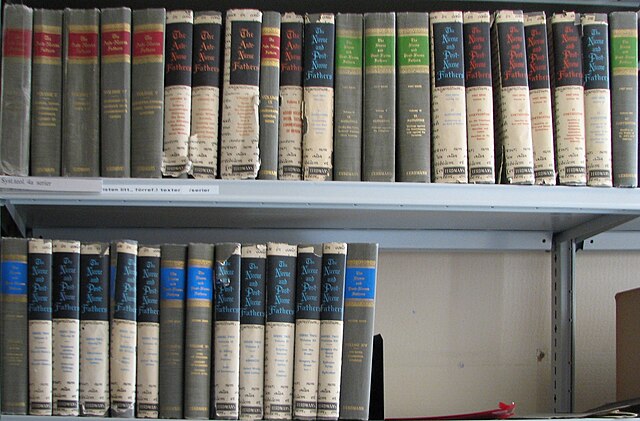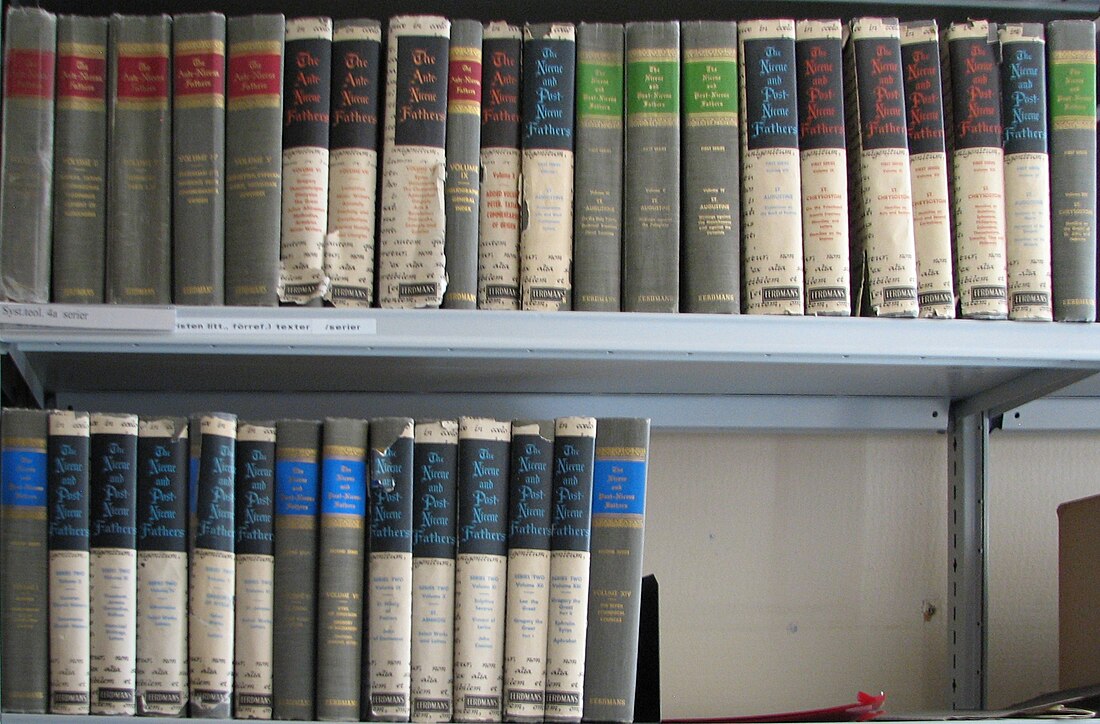Top Qs
Timeline
Chat
Perspective
Patristics
Study of the early Christian writers who are designated Church Fathers From Wikipedia, the free encyclopedia
Remove ads
Patristics, also known as patrology, is a branch of theological studies focused on the writings and teachings of the Church Fathers, between the first and the eighth centuries AD. Scholars analyze texts from both orthodox and heretical authors. Patristics emerged as a distinct discipline in the 19th century, supported by critical editions like Patrologia Latina and Patrologia Graeca. The field employs textual analysis, archaeology, and historical criticism to analyze early Christianity's doctrinal, cultural, and intellectual development, incorporating traditions beyond Greek and Latin, such as Syriac, Coptic, Armenian, and Ethiopian.

Remove ads
Etymology
Patrology, derived from the Latin pater (father) and Greek logos (discourse), primarily refers to the study of the Church Fathers and serves as an introduction to early Christian writings. Historically, it also included large compilations of these writings, such as Patrologia Latina and Patrologia Graeca compiled by the French scholar Jacques Paul Migne.[1]
The term patristics similarly originates from pater in Latin and πᾰτήρ in Greek, both meaning "father," and was introduced by English philosopher Isaac Taylor.[2] Meanwhile, Patrologia was coined by Johann Gerhard, who published a book by the same name in 1653.[3] The formal classification of patristics as a distinct theological discipline was later established by Johann Franz Buddeus in his Historical and Systematic Introduction to Theology (1730).[4]
Remove ads
Scope
Summarize
Perspective
Patristics is the study of the writings and thought of the Church Fathers, theologians active from the late 1st century to the 8th century AD, a period known as "the Patristic Age".[5] The Church Fathers played a key role in defending orthodox Christianity against heresies and interpreting the faith.[5] Closely linked to Church history and early Christian doctrine, it analyzes primary sources that shaped Christian theology, including polemical writings, orations, sermons, letters, and poems, as well as systematic treatises on doctrine and works of biblical exegesis and scriptural commentary. Additionally, Patristic texts span diverse traditions, cultural contexts, and languages, including Greek, Latin, Syriac, Ethiopian, Armenian, and Coptic.[6] The Catholic Church noted at the Second Vatican Council that "the study of the holy Fathers of both East and West and of sacred liturgies" was an important complement to the study of sacred scripture.[7]
Modern scholars, such as Shawn J. Wilhite (2024), define Patristics as spanning from 90–750 AD and incorporating both orthodox and heretical writings for historical context.[8][9] The field employs a multidisciplinary approach, integrating textual analysis, archaeology, art history, philosophy, and religious history to reconstruct early Christianity's intellectual and cultural landscape.[10]
Patrology and patristics
Some scholars, particularly in Germany, distinguish patrology from patristics. Josef Fessler defines patrology as the study of the authenticity, authority, and use of the Church Fathers' works, while patristics focuses on their theological thought. Karl Keating similarly describes patrology as the study of the Fathers as historical figures, whereas patristics examines their teachings. However, these distinctions are not widely observed, as both fields overlap within theological and literary studies.[11][12]
Remove ads
Historical development
Summarize
Perspective
Early engagement (pre-5th century)
Eusebius is identified as the earliest to document the history of Christian literature. According to his 4th-century book Ecclesiastical History, states his intention to report on those who were ambassadors of the word of God by speech or by pen, listing their names, numbers, and ages. Thus, his work is a crucial source of Patrology, especially as many writings he quotes have been lost, making him the only source of information for some ecclesiastical authors.[13]
During the same century, Jerome was the pioneer in documenting the history of Christian theological literature. In his work De viris illustribus (On Illustrious Men), he aimed to address the mockery from pagans who often ridiculed the intellectual capabilities of Christians.[13]
With the advent of the printing press in the 15th century, interest in patristic writings surged. Medieval scholars, Protestant Reformers, and Caroline divines extensively studied the Church Fathers, particularly figures such as Augustine, Jerome, and John Chrysostom. However, these studies were often influenced by apologetic and polemical lenses, reflecting the theological debates of the time.[14]
Emergence as a discipline (15th–19th century)
Modern patristics emerged in the 19th century, spurred by institutions, such as universities, seminaries, and academic conferences. The development of scholarly tools, including critical editions of texts (e.g., Patrologia Latina) and journals like Studia Patristica.[15] Additionally, continued ecumenical dialogue reduced tensions between Chalcedonian and Oriental Orthodox traditions allowing for revitalized interest in non-Greek/Latin Fathers.[16]
During the late 19th and early 20th centuries, scholars in Great Britain, Germany, France, and Italy made significant philological advancements, acquiring and cataloging new manuscripts. The discovery of the Nag Hammadi Gnostic library and John Chrysostom's baptismal catecheses on Mount Athos (1955) were major milestones.[17]
With the introduction of microfilming technology, institutions like the British Library, Vatican Library, and Bibliothèque Nationale preserved and expanded access to patristic manuscripts. Since the 1940s, scholarly efforts have focused on careful textual revisions and comparative analyses rather than new manuscript discoveries.[17]
Modern scholarship
Modern scholars have increasingly recognized diverse Christian communities beyond Rome and Constantinople. Other major locations where the early Church fathers were based included Alexandria, Antioch, and the area of western north Africa around Carthage. Milan and Jerusalem were also sites.[18] This shift in recognition has led to a more nuanced understanding of the Church Fathers' impact across different traditions. Some theologians revered in one tradition were considered heretical in another, highlighting the theological diversity of early Christianity.[19]
The Western definition of the Patristic Age has also been re-evaluated. Traditionally, Venerable Bede (d. 735) marks its conclusion in the Latin West, and John of Damascus (d. 749) in the Greek East. However, later Byzantine theologians such as Symeon the New Theologian and Gregory Palamas, along with Oriental Orthodox figures, continue to be studied in Patristics. This re-evaluation challenges Eurocentric periodization and acknowledges the continued intellectual and theological evolution of Christianity beyond the traditional Western framework.[19]
Remove ads
Theological developments
Major focuses for these theologians during the period are, in chronological order:[20]
- Christianity's relationship with Judaism
- Establishment of the New Testament canon
- Apologetics (the 'defense' or 'explanation' of Christianity)
- Doctrinal discussions that sought to achieve consistency of faith, in particular within the Christianized Roman Empire.
Furthermore, McGrath (1998) notes several major areas of theology can be seen to have developed during the Patristic Period: the extent of the New Testament canon, the role of tradition, the fixing of the ecumenical creeds, the two natures of Christ, the doctrine of the Trinity, the doctrine of the Church, and the doctrine of divine grace.[21]
Remove ads
Notable Church Fathers
Some key individuals of patristic literature include:[22]
- Justin Martyr (c. 100 – c. 165)
- St. Irenaeus of Lyons (c. 130 – c. 200)
- Origen (c. 185 – c. 254)
- Tertullian (c. 160 – c. 225)
- St. Athanasius (c. 296 – c. 373)
- St. Augustine of Hippo (354–430)
- St. Gregory the Great (c. 540 – 604)
Contemporary approaches
Understanding patristics in the 21st century presents several challenges. McGrath identifies four key difficulties: the perceived lack of relevance in some theological debates, the influence of classical philosophy, the doctrinal diversity among the Church Fathers, and the divisions between Greek (Eastern) and Latin (Western) theological traditions, particularly in their use of philosophical frameworks.[23]
In response to these challenges, neo-patristic and post-patristic approaches advocate for reinterpreting or critically reassessing the Church Fathers in light of modern developments. These perspectives argue that early Christian writings reflect the concerns of their historical context and may require adaptation. However, these approaches remain controversial among orthodox theologians, who caution that such reinterpretations could undermine traditional theological continuity.[24][25]
Remove ads
Sources and collection of texts
Summarize
Perspective
Original language collection
A vast number of patristic texts are preserved in their original languages through major scholarly collections. One of the most comprehensive efforts is Jacques Paul Migne's Patrologia Latina and Patrologia Graeca, which compile extensive writings from the Latin and Greek Church Fathers, respectively.[26]
For texts in Syriac and other Eastern languages, the Patrologia Orientalis (formerly Patrologia Syriaca) provides a significant, though incomplete, collection. It is largely supplemented by the Corpus Scriptorum Christianorum Orientalium, which includes additional Eastern Christian writings.[27][28]
Other critical editions and re-edited patristic texts, including newly discovered works and revised attributions, are found in:
Peer-reviewed journals
Several peer-reviewed journals are recognized for their contributions to the study of early Christianity and Patristics. These journals, many of which are accessible online, include:[29]
- Semeia
- The Catholic Biblical Quarterly
- The Harvard Theological Review
- Zeitschrift für antikes Christentum
- Antike und Christentum: Kultur- und Religionsgeschichtliche Studien
- Early Christianity
- Connaissance des Pères de l'Église
- Journal of Early Christian History (University of South Africa)
- Journal of Early Christian Studies
- Journal of Greco-Roman Christianity and Judaism
- The Journal of Late Antique Religion and Culture
- The Second Century
- Vigiliae Christianae
- Recherches de Théologie Ancienne et Médiévale
- Recherches Augustiniennes et Patristiques
- Newsletter of the North American Patristic Society
- Patristic Studies (The Catholic University of America)
Remove ads
See also
Ancient Christian texts and collections
- Nag Hammadi library
- Dead Sea Scrolls (related to Jewish-Christian textual traditions)
- Christian Classics Ethereal Library (free editions of patristic texts)
- Popular Patristics Series (modern translations of patristic works)
Academic fields and studies
- Armenian studies
- Coptology
- Ethiopian studies
- Syriac studies
- Papyrology (study of ancient Christian manuscripts)
- Historiography of early Christianity
Key theological and historical topics
- Early Christianity
- Consensus Patrum (Church Father's teachings as doctrine)
- First seven ecumenical councils (core doctrinal developments)
- Church Fathers (main figures of patristics)
- Hellenistic Judaism (intellectual background of early Christian writings)
Remove ads
References
Sources
External links
Wikiwand - on
Seamless Wikipedia browsing. On steroids.
Remove ads
